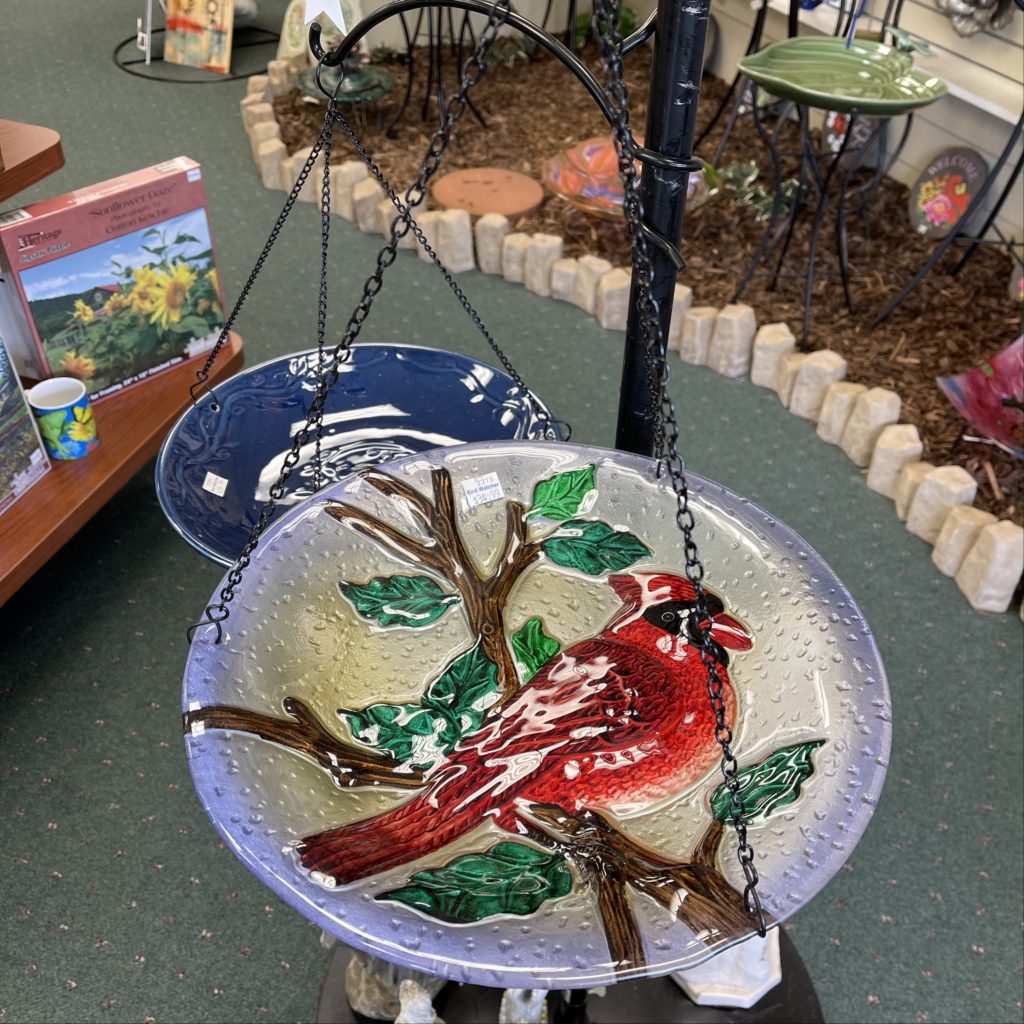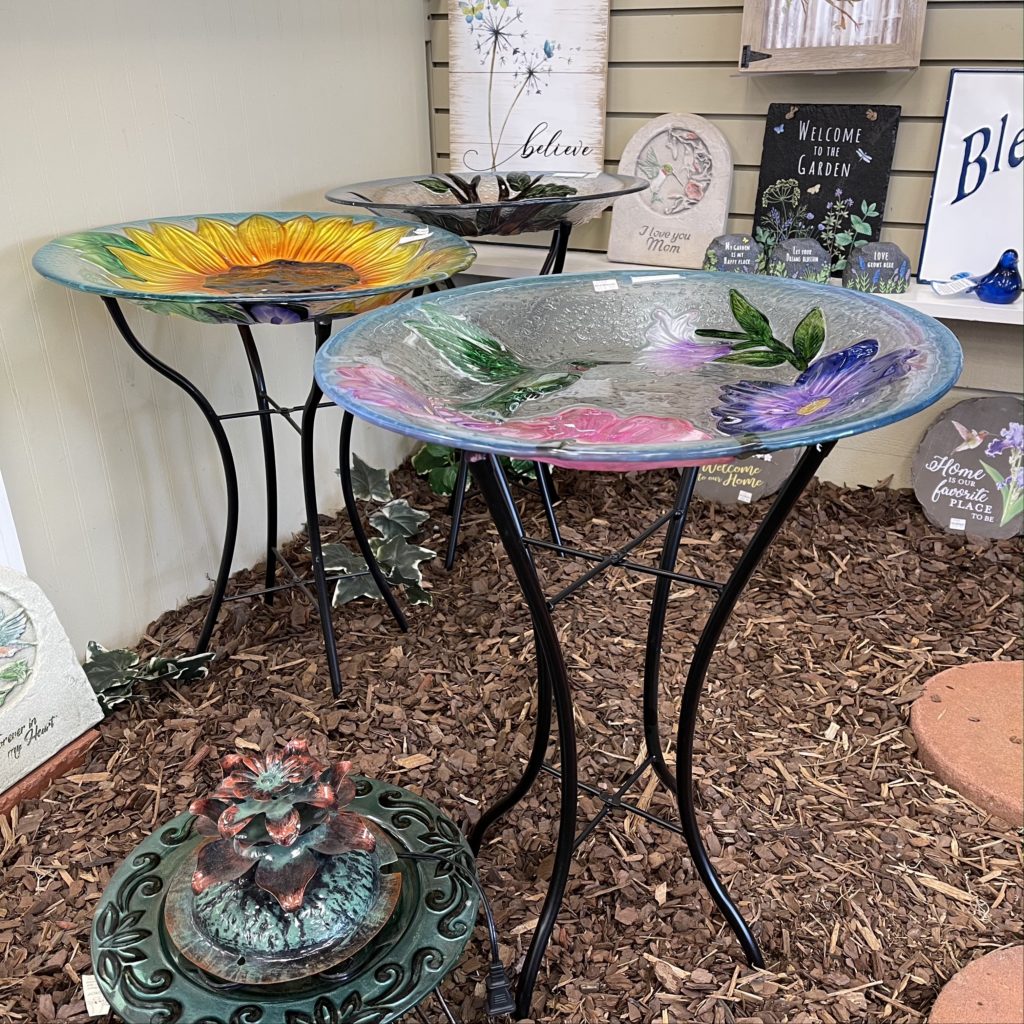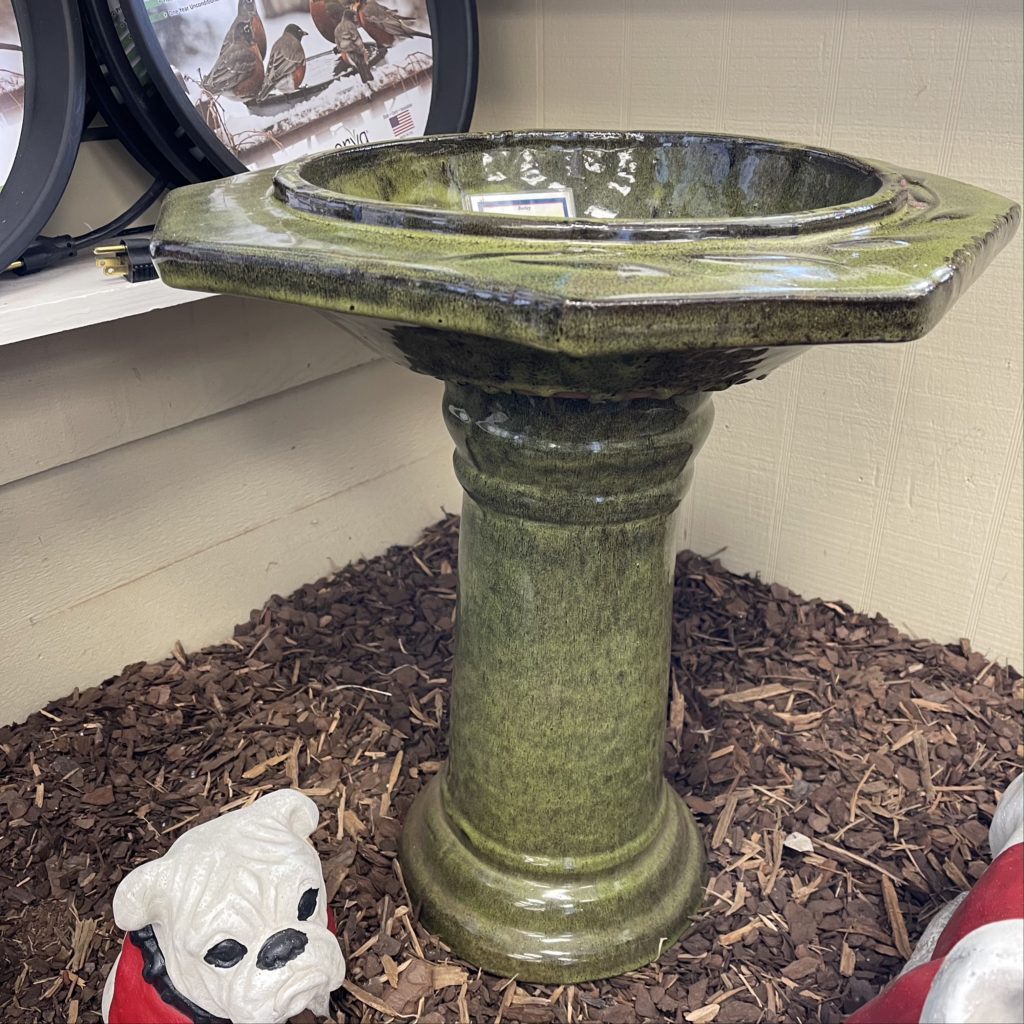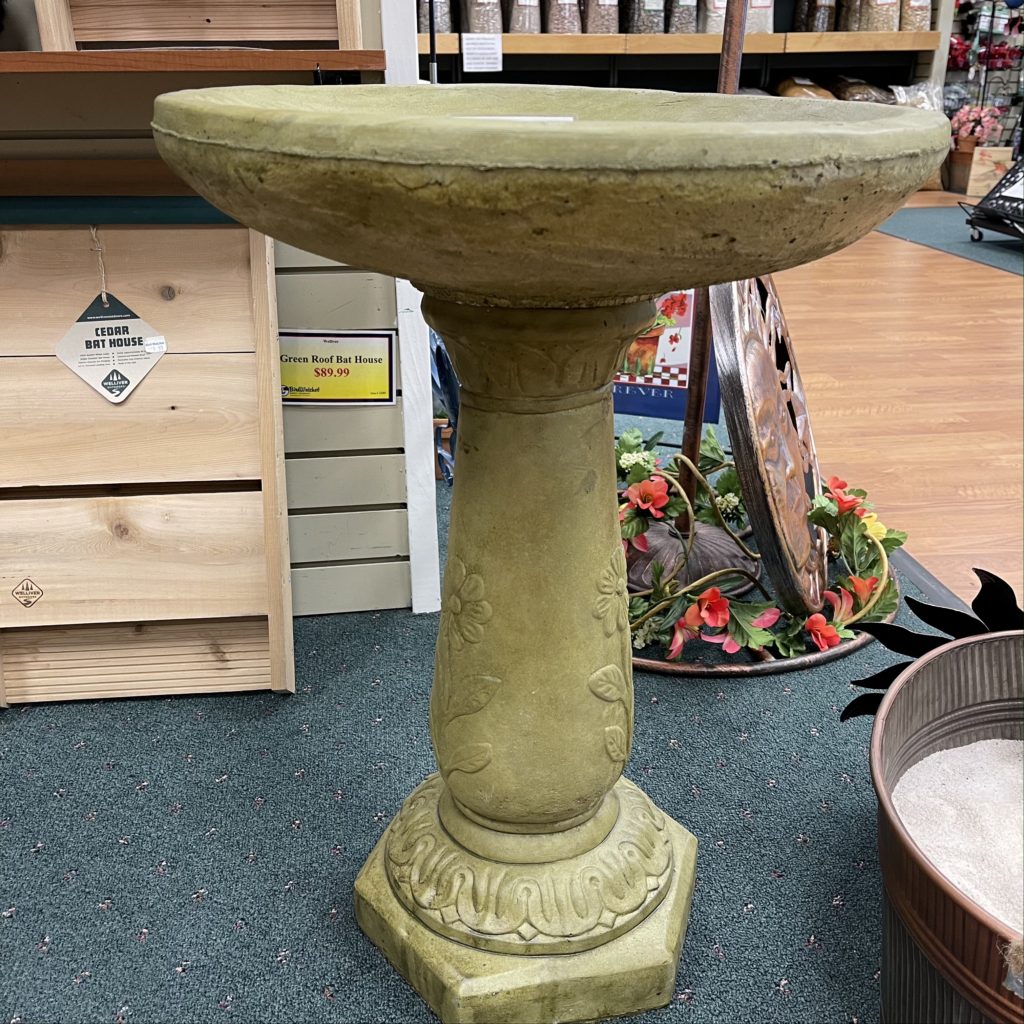
Does your childhood remind you of watching birds flock up near your house or perched on a nearby tree? Are you an avid birdwatcher? Do you love to observe these little creatures up close? Do you have a beautiful garden and would like to place a decorative bird bath fountain? If you are someone who enjoys nature, a bird bath is a perfect investment.
If you are wondering where to begin regarding bird baths, this article will provide you with all the information you need to get started.
Types of Bird Baths
When it comes to selecting a particular bird bath, there are so many options; it might end up being a little overwhelming. Fortunately, some are better suited than others in certain situations.
Classic Bird Bath With a Stand
Classic bird baths with a stand are the most common and obvious ones which serve one purpose and nothing else. They come mounted on a stand, they are sturdy, and can hold an adequate amount of water. They can be very cost-efficient, depending on how simple or elaborate the design is. Something to make sure of is that you have a flat, even area of land where they can be placed firmly.
Hanging Bird Bath
Hanging bird baths are very simple, cost-efficient, and handy. They are usually shallow and need to be filled almost every day. Hanging bird baths may not be very aesthetic, but you can hang them from practically any surface. Another great advantage of these bird baths is that they can be cleaned easily.
Bird Bath with a Fountain
If you are looking for more decorative and elaborate design structures to adorn your garden, a fountain is a perfect choice. A bird bath fountain adds a different dynamic touch with its moving water, and the birds also seem to enjoy these a bit more than the regular ones. There are plenty of varieties available to suit different needs, and they can add just the right amount of spark to your garden.
Ground Bird Bath
Ground bird baths are highly functional and simple and they rest on the ground, as the name suggests. These provide a very similar experience for the birds to how water may be available naturally, so birds might be more comfortable around these bird baths. Ground bird baths also attract birds that cannot fly like Ducks and Quails, which may not be the case when it comes to elevated baths.
Making a Bird Bath
Essentially, a bird bath is any bowl in which a bird can either drink water or take a dip in. A DIY bird bath is not very difficult to make, especially if it is a ground bird bath. In fact, they can be as simple as placing a size-appropriate bowl on the lawn. However, this looks very boring and unappealing. One can get creative when it comes to using other objects as a bird bath.
One of our favorites is using a bundt cake pan turned upwards to be a bird bath. An upturned lid can also be repurposed as a bird bath. Cups, plates, bowls, and lids can all be repurposed to make cute bird baths. One can bring about height as an added dimension by using lamps, vases, stands, and stools. Hanging bird baths are another easy DIY project. You can suspend plates or lids with chains.
Decorating is an integral part of a DIY bird bath. Almost anything that catches your attention can be used. Pebbles, colored marbles, paint, mosaics, or mirrors are some of the most common elements. It is crucial to place stones and pebbles of different sizes in order to provide a comfortable surface of different heights for different-sized birds. While these are some of the more straightforward methods of making a DIY bird bath, there are a few more techniques for more elaborate ones.
You can get creative by making molds of different shapes using concrete. Tiny figurines may also be placed appropriately to complete the look. Another creative idea is to install misters and drippers to introduce movement into the bird bath.
Now that you have a general idea about bird baths, let’s look at one of the more exciting and dynamic pieces: a bird bath fountain.
Why Should You Use Bird Bath Fountains?
We already know what a bird bath fountain is, but why is it superior to the others?
A bird bath fountain is constantly providing a moving source of water. This mimics a natural element seen in streams, and this cascading motion automatically attracts birds to take a dip in it.
A circulating source of water keeps the bird bath cleaner than having a stagnant source. Mosquitoes and other pests would find it difficult to breed in these. It also provides a very soothing water splash sound that is quite relaxing to the ears.
Materials Used in Bird Bath Fountains
Apart from these styles, the bird bath fountains can also be made from different materials. Picking an appropriate medium for your garden or lawn is very important. Here are some of the materials that are commonly seen:
Glass
Materials like glass provide an exciting aesthetic when placed in the yard, but one needs to make sure that they are placed in a safe spot. You need to be wary of cracks and ragged edges on a glass bird bath fountain, which would injure that the birds will come by for a dip.
Cement
Cement is a favorite material to use amongst many as it is cost-efficient and durable. There are many designs available for a cement bird bath fountain, the only problem is that they tend to be bulky. These are usually poured in two parts and are assembled separately.
Metal
Bird bath fountains with many intricate designs are available in metal. These are much more durable and also blend in well with the natural setup. The fact that they are metallic might provide some warmth to the water, which acts as a natural heated bird bath.
Copper bird bath fountains are also becoming more popular. Copper gives a vintage look that adds value to the garden. These fountains are also very durable and they aren’t as heavy as other metal ones. Copper bird bath fountains also have the unique advantage of being biostatic. Their surface will not allow the growth and adherence of algae and bacteria, which means it would get dirty less often and be more hygienic and safe.
Ceramic
Another interesting material is ceramic. These fountains are sure to grab everyone’s attention and become the centerpiece of your garden. Of course, ceramic is also a delicate and expensive material compared to some of the others.
Types of Bird Bath Fountains
There are many types of bird bath fountains. We have already discussed the various materials, but various designs give off different appeals.
1. Some models have a waterfall setup with rocks and twigs formed into a staircase. These are very popular as they mimic natural aesthetics.
2. Some fountains have ascending-sized plates or bowls which flow sequentially. They are made to be geometrically proportional. These are very satisfying to watch and also provide a larger area for more birds to use. There are also dribblers, sprays, mists, water wigglers, and drippers that could be added to the fountain to make it more interesting.
3. Another design, which is also an eco-friendly alternative is a solar bird bath fountain. Solar-powered bird bath fountains are a wise investment because the baths are mostly kept in direct sunlight. Making use of the sun as a power source means that you don’t need to look for other sources and it also saves money over time.
Solar bird bath fountains do not need large pumps or heavy electrical wiring either. You can also feel good about being eco-friendly and aesthetic. You need to keep in mind that this fountain should be placed in an area where it can absorb as much sunlight as possible. These fountains can’t be used when the sunlight is inadequate. The other drawback is that it comes with a size limitation since solar power can’t support huge pumps.
4. Heated bird baths are pretty popular in colder countries. During the winter, most of the surrounding natural water resources are cold and even frozen. With a little more investment, you can equip your garden with a heated bird bath fountain. This will automatically draw the birds towards the water fountain.
Hummingbird Bird Baths
We have established that not all bird baths have the same look and appearance. However, there are some important points to note when it comes to a Hummingbird bird bath.
Hummingbirds are very small and nimble birds known to fly in all directions and even hover at some points! These remarkable birds do no like regular bird baths.
Since they are tiny, they stay away from large, deep water sources. A shallow plate or lid with pebbles would be better suited for these creatures.
Bird bath fountains are the most preferred by these birds as there is enough space for them to walk with plenty of shallow areas to take a rest.
A Hummingbird bird bath can be made interesting by installing misters, bubblers, and sprinklers with a gentle spritz of water. Make sure there are many perches for the bird around the bath.
Regular cleaning of freshwater is of utmost importance as these birds are very sensitive.
Maintenance of a Bird Bath Fountain
One of the most important aspects of owning a bird bath is maintaining it. Each type of bird bath has to be catered to differently. Birds visit these for a quick dip or a drink and usually end up making the water very dirty. They wash off a lot of bacteria, feathers and even leave bird droppings in the water.
It is very important to make sure that the water is clean or this could make your visitors sick. If you become lazy with its maintenance, the fountain will become a source of disease for both birds and humans.
Depending on the size and weight of the bird bath fountain, you can choose to place it underneath a water source or use a hose to clean it. If it’s big, bulky then you can wash it in the same place it is setup using brushes and jets of water. Some even recommend soaking your bird bath fountain in bleach or vinegar before washing it off.
Changing the water regularly is very important. This is more applicable if the fountain is not constantly moving water or if it’s switched off most of the time. Stagnant water is a breeding ground for many pests like mosquitoes. The bottom surface may begin accumulating algae and bacteria. Experts recommend that the water is drained and
replaced once every three days or so.
While bird bath fountains that are in motion may not stagnate water, the water will evaporate much faster because it is constantly circulating. It is important to keep renewing the source of water. Ensure that the water running through the pipes is warm during winters since cold water might freeze and ruin the pipes. There are many heated bird bath fountains available on the market. A solar heater can also be installed separately. If you cannot afford a heated bird bath, it is better not to operate them during harsh winters.
To prevent frequent accumulation of debris, avoid placing bird baths under trees, where leaves and twigs may fall into it. This makes for easy maintenance of your bird bath. While it is not placed directly under a tree, it is advisable to place it in the vicinity of a tree or bush. This offers protection from predators.
Final Words
Having a bird bath fountain is a gratifying decision. As an accessory, the bird bath alone will look elegant in the garden. As a source of water, it will attract many birds to enjoy and take a few dips in the fountain. One can catch glances of the most adorable behaviors from birds.
If you place a bird bath, it is easy to spot many different species with little to no effort. However, all great things come with a price, and the price for this lies in its maintenance. If the bird bath fountain is not maintained regularly, one may end up doing more harm than good.
You can set goals to bird-watch after you have placed your bird bath fountain in your backyard and record your results.











